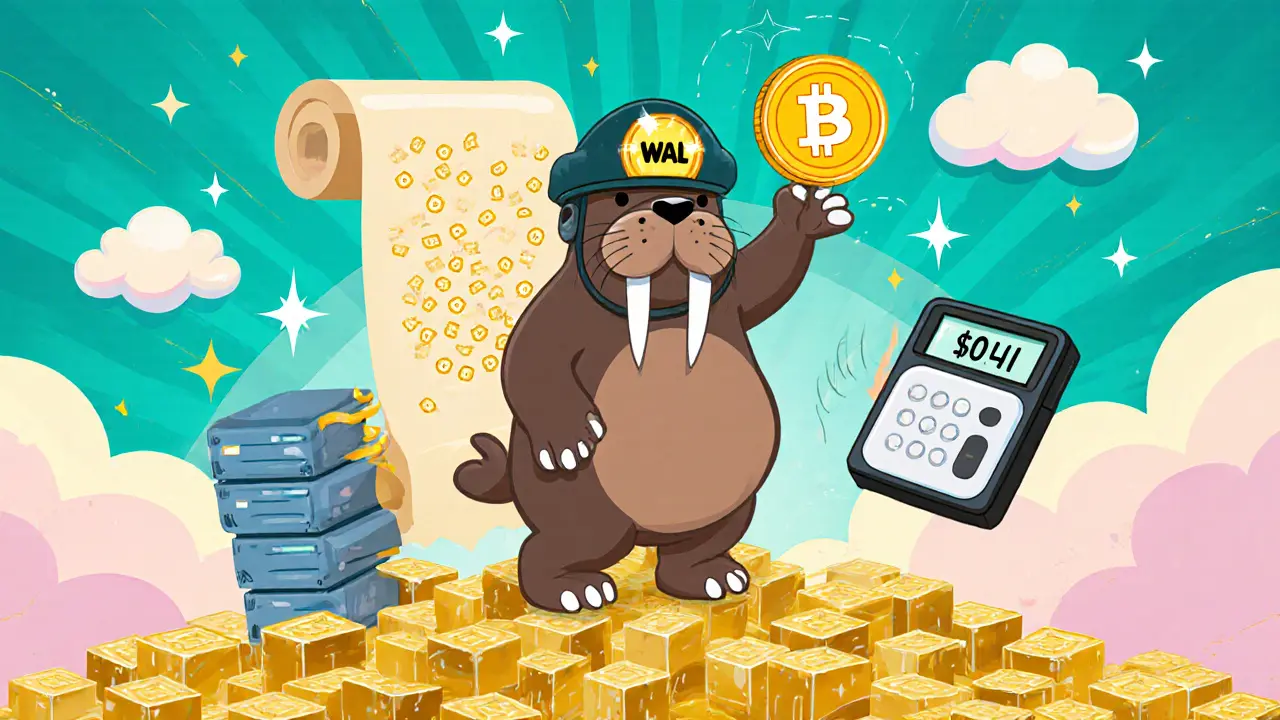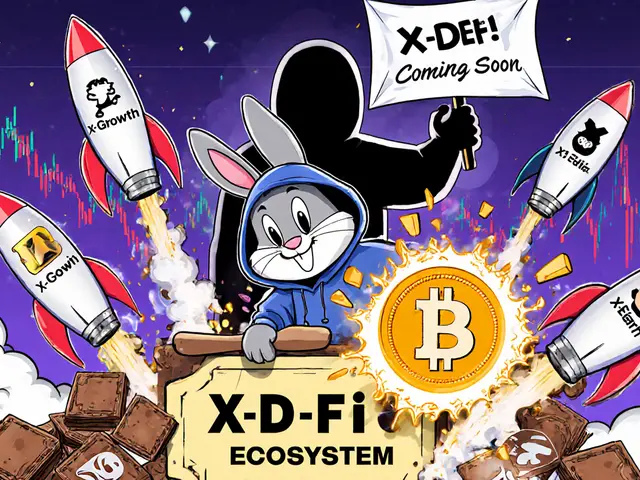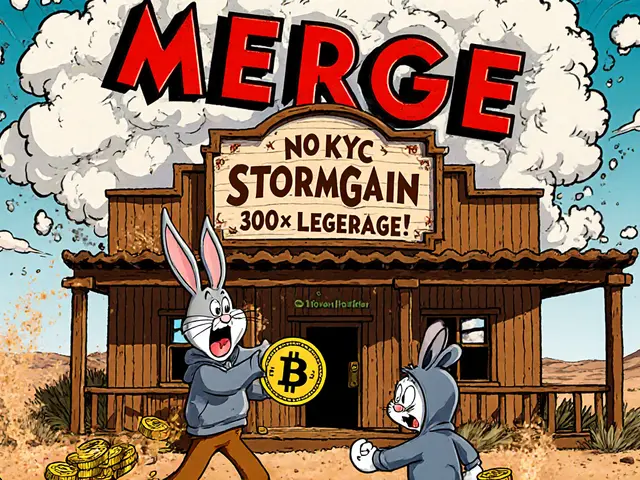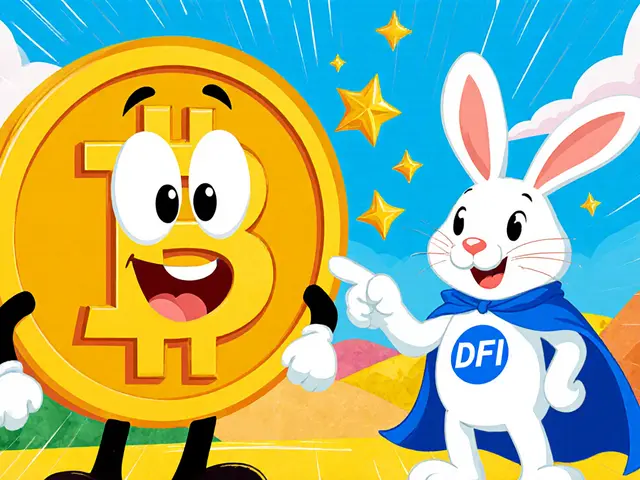
Walrus (WAL) Token Price Calculator
Token Value Calculation
Tokens Held:
0 WAL
Current Price:
$0.00
Total Value:
$0.00
Walrus (WAL) Market Overview
Market Cap: $603.5M
Circulating Supply: 1.47B WAL
Total Supply: 5B WAL
24h Volume: $20.3M
FDV: $2.04B
Current Price: $0.409
Walrus is a decentralized storage protocol built on the Sui blockchain that specializes in storing large binary files-often called “blobs.” It was launched in 2024 by Mysten Labs, the team behind Sui. The protocol tackles the messy problem of putting videos, 3D assets, AI datasets, and other hefty files on‑chain without exploding gas fees.
The Walrus WAL token powers the network, covering storage payments, staking rewards, and governance voting.
Quick Summary
- Walrus stores large binary data on Sui using erasure coding and Byzantine fault‑tolerance.
- WAL token supplies payment, security, and voting rights.
- Market cap ~US$604M; price around US$0.41 (Oct2025).
- Key advantage: cheaper, faster large‑file storage than IPFS or Arweave.
- Earn rewards by staking WAL and participate in protocol upgrades.
What Is Walrus and the WAL Token?
At its core, Walrus is a storage layer that lives on top of the Sui blockchain. Developers write Move‑based smart contracts that call Walrus APIs to upload a blob. The system splits the blob into small shards, runs erasure coding to add redundancy, and spreads the pieces across a network of storage nodes that all run inside Sui’s ecosystem.
The native cryptocurrency, WAL token, has a capped supply of 5billion, with about 1.47billion already circulating. Token holders lock up (stake) WAL to become storage providers, earn a share of the fees paid by users, and get voting power for protocol decisions.
How Walrus Stores Big Files
Traditional blockchains struggle with large files because each byte costs gas. Walrus sidesteps that by using erasure coding-a technique borrowed from RAID systems. When you upload a 10GB video, the protocol:
- Divides the video into dozens of small chunks.
- Creates parity shards so that any missing piece can be reconstructed.
- Distributes the shards across dozens of independent nodes.
- Stores a tiny proof on the Sui ledger that links the shards together.
Walrus also employs Byzantine fault‑tolerance (BFT). Even if up to one‑third of the nodes act maliciously, the network can still retrieve the original data because the redundancy built in by erasure coding guarantees enough honest shards remain.

Tokenomics and Market Snapshot (Oct2025)
Here’s the quick math:
- Total supply: 5billion WAL.
- Circulating supply: 1.47billion WAL.
- Current price: US$0.409.
- Market cap: US$603.5million.
- 24‑hour volume: US$20.3million.
- Fully diluted valuation (FDV): US$2.04billion.
The token allocation is purpose‑driven. Ten percent (500million WAL) is earmarked for user incentives-4% went out as an airdrop at launch, and the remaining 6% is reserved for future community rewards. The rest funds development, ecosystem grants, and liquidity pools.
Walrus raised $140million from Tier1 VCs (including Andreessen Horowitz and Franklin Templeton) at a $2billion pre‑money valuation. The vesting schedule is conservative: about 1% of total supply (~$13million) unlocks each month in the first year, which helps dampen price‑selling pressure despite the healthy daily trading volume exceeding $100million.
Walrus vs. Other Decentralized Storage Solutions
| Feature | Walrus | IPFS | Arweave |
|---|---|---|---|
| Primary focus | Large binary blobs (videos, AI data) | General content-addressed files | Perma‑storage of any data |
| Underlying blockchain | Sui | None (peer‑to‑peer) | Arweave native blockchain |
| Cost model | Pay‑per‑GB using WAL token (often cheaper than cloud) | Free to upload; users pay for pinning | One‑time upfront fee per byte |
| Scalability for large files | Erasure‑coded shards + BFT, designed for GB‑scale | Chunking works but bandwidth limits exist | Optimized for permanence, not speed |
| Governance | WAL token‑based voting | Community‑driven via GitHub | AR token voting |
In short, if you need to serve a 5GB video to a global dApp with low latency, Walrus is a better fit than IPFS or Arweave, which were built for different use cases.
Using WAL: Staking, Payments, and Governance
Getting started is simple:
- Acquire WAL on any major exchange (most list the token under the ticker “WAL”).
- Send WAL to a supported wallet that can interact with the Sui network.
- Stake your WAL through the official Walrus staking portal. The more you lock, the higher your chance of being selected as a storage node and earning fees.
- When you upload a file via the Walrus SDK, the protocol automatically deducts the required amount of WAL from your wallet and records the payment on‑chain.
- To vote on proposals-like fee adjustments or protocol upgrades-navigate to the governance dashboard, lock a voting amount of WAL, and cast your vote.
Staking rewards currently hover around 8‑12% APR, depending on network utilization. Because rewards are paid in the same token you’re staking, you benefit from both fee income and potential price appreciation.
Risks, Opportunities, and the Road Ahead
Every crypto project has trade‑offs. For Walrus the biggest risk is user education: the protocol asks developers to think about on‑chain storage costs, redundancy parameters, and staking requirements-concepts that are still new to many Web3 teams. A poorly timed airdrop sell‑off could also pressure the price.
On the upside, the market for on‑chain AI training data and 3D gaming assets is exploding. Analysts at BlockBase predict that specialized storage solutions could capture 15‑20% of the decentralized storage market by 2028, and Walrus sits in a sweet spot with its Sui integration.
The roadmap includes:
- Cross‑chain adapters for Solana and Ethereum, widening the addressable user base.
- Advanced SDKs in Rust, TypeScript, and Python to lower the barrier for AI developers.
- Dynamic pricing algorithms that auto‑adjust storage fees based on network load.
- Further BFT optimizations to improve data retrieval speeds under heavy load.
If those milestones hit on schedule, the protocol could become the go‑to storage layer for any Web3 project that needs megabytes to terabytes of data on‑chain.

Frequently Asked Questions
What types of files can I store on Walrus?
Walrus is built for large binary blobs-video files, high‑resolution images, 3D models, AI training datasets, and any other data that exceeds the size limits of typical blockchain storage solutions.
How does Walrus ensure my data isn’t lost if nodes go offline?
Through erasure coding and Byzantine fault‑tolerance. The protocol creates extra parity shards, so even if several nodes disappear, the remaining shards can reconstruct the original file.
Do I need Sui to interact with Walrus?
Yes. All storage transactions settle on the Sui blockchain, so you’ll need a Sui‑compatible wallet and some SUI gas to cover transaction fees.
Can I earn WAL by just holding the token?
Holding alone doesn’t generate rewards. To earn, you must stake WAL as a storage provider or participate in the protocol’s incentive programs.
Is Walrus safe for mission‑critical data?
The BFT architecture and redundancy make it highly reliable, but like any decentralized system you should still back up critical data off‑chain as a precaution.





